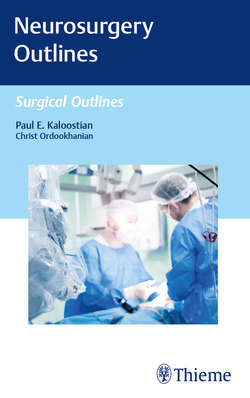Читать книгу Neurosurgery Outlines - Paul E. Kaloostian - Страница 36
На сайте Литреса книга снята с продажи.
Surgical Procedure for Posterior Cervical Spine
Оглавление1. Informed consent signed, preoperative labs normal, no Aspirin/Plavix/Coumadin/other anticoagulants for at least 2 weeks for elective cases
2. Appropriate intubation and sedation and lines (if necessary) as per the anesthetist
3. Patient placed prone with Mayfield pins in neutral alignment on Jackson Table with all pressure points padded
4. Neuromonitoring may be present to monitor nerves (if necessary and indicated)
5. Time out is performed with agreement from everyone in the room for correct patient and correct surgery with consent signed
6. Make an incision over the vertebrae where laminectomy is to be performed
7. Perform subperiosteal dissection of muscles bilaterally to expose the vertebra
8. Once the bone is exposed, it is best to localize and verify the correct vertebra via X-ray or fluoroscopic imaging and confirming with at least two people in the room
9. Perform the laminectomy over segments needed based on preoperative imaging of levels that are compressed due to tumor:
a. Using Leksell rongeurs and hand-held high-speed drill, remove the bony spinous process and bilateral lamina as indicated for specific procedure
b. Remove the thick ligamentum flavum with Kerrison rongeurs with careful dissection beneath the ligament to ensure no adhesions exist to dura mater below and thus avoiding CSF leak
c. Perform appropriate foraminotomy with Kerosen rongeurs as needed for appropriate decompression of nerve roots
d. Identify location of tumor and resect tumor as needed if within the lamina, epidural, or within the spinal canal/cord:
i. If within the lamina or epidural in nature, the tumor can be visualized immediately and removed gently
ii. If within the spinal cord, use operative microscope and open the spinal cord dura midline with 11 blade and tack up the dural leaflets with suture
iii. If tumor is intradural and extramedullary, it can be resected carefully with microdissection technique without cord injury (neuromonitoring needed in these cases) (see ▶Fig. 1.14)
iv. If tumor is intradural and intramedullary, with microdissection technique the cord must be entered midline and the tumor must be identified and resected starting centrally first, then around the edges (neuromonitoring needed in these cases)
10. After appropriate tumor resection, there may be need for additional stabilization to prevent kyphosis if the resection caused multiple segment decompression. Therefore, instrumentation with lateral mass screws can be placed over the segments involved with rods bilaterally and fusion/arthrodesis along these segments. (see ▶Fig. 1.15 and ▶Fig. 1.16)
11. After appropriate hemostasis is obtained, muscle and skin incisions can then be closed in appropriate fashion, often with placement of postoperative drains that can be removed after 2 to 3 days.
Fig. 1.14 (a–d) Radiology revealed tumor at the C5 level, accompanying severe cord compression. After dissecting to the tumor, it was successfully resected. (Source: Intradural extramedullary tumors. In: Bernstein M, Berger M, eds. Neuro-oncology: The Essentials. 3rd ed. Thieme; 2014).
Fig. 1.15 (a, b) Preoperative imaging revealed cervical ependymoma. Postoperative imaging demonstrates total removal of tumor. (Source: Intramedullary spinal cord tumors: ependymomas and astrocytomas. In: Nader R, Berta S, Gragnanielllo C, et al, eds. Neurosurgery Tricks of the Trade: Spine and Peripheral Nerves. 1st ed. Thieme; 2014).
Fig. 1.16 (a, b) Radiology revealed a cervical lymphoma and lysis of C3 in an elderly man. Anterior corpectomy and posterior stabilization were performed and confirmed via postoperative CT scan. (Source: Vertebral bone tumors. In: Fessler R, Sekhar L, eds. Atlas of Neurosurgical Techniques: Spine and Peripheral Nerves. 2nd ed. Thieme; 2016).
